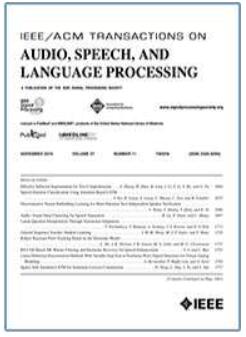Interference-Controlled Maximum Noise Reduction Beamformer Based on Deep-Learned Interference Manifold
IF 5.1
2区 计算机科学
Q1 ACOUSTICS
IEEE/ACM Transactions on Audio, Speech, and Language Processing
Pub Date : 2024-10-23
DOI:10.1109/TASLP.2024.3485551
引用次数: 0
Abstract
Beamforming has been used in a wide range of applications to extract the signal of interest from microphone array observations, which consist of not only the signal of interest, but also noise, interference, and reverberation. The recently proposed interference-controlled maximum noise reduction (ICMR) beamformer provides a flexible way to control the specified amount of the interference attenuation and noise suppression; but it requires accurate estimation of the manifold vector of the interference sources, which is challenging to achieve in real-world applications. To address this issue, we introduce an interference-controlled maximum noise reduction network (ICMRNet) in this study, which is a deep neural network (DNN)-based method for manifold vector estimation. With densely connected modified conformer blocks and the end-to-end training strategy, the interference manifold is learned directly from the observation signals. This approach, akin to ICMR, adeptly adapts to time-varying interference and demonstrates superior convergence rate and extraction efficacy as compared to the linearly constrained minimum variance (LCMV)-based neural beamformers when appropriate attenuation factors are selected. Moreover, via learning-based extraction, ICMRNet effectively suppresses reverberation components within the target signal. Comparative analysis against baseline methods validates the efficacy of the proposed method.基于深度学习干扰矩阵的干扰控制型最大降噪波束成形器
波束成形已被广泛应用于从麦克风阵列观测数据中提取感兴趣的信号,这些观测数据不仅包括感兴趣的信号,还包括噪声、干扰和混响。最近提出的干扰控制最大降噪(ICMR)波束成形器提供了一种灵活的方法来控制干扰衰减和噪声抑制的指定量,但它需要精确估计干扰源的流形向量,这在实际应用中很难实现。为了解决这个问题,我们在本研究中引入了干扰控制最大降噪网络(ICMRNet),这是一种基于深度神经网络(DNN)的流形向量估计方法。通过密集连接的修正构象块和端到端训练策略,干扰流形可直接从观测信号中学习。这种方法与 ICMR 相似,能很好地适应时变干扰,与基于线性约束最小方差(LCMV)的神经波束成形器相比,在选择适当的衰减因子时,具有更高的收敛速度和提取效率。此外,通过基于学习的提取,ICMRNet 还能有效抑制目标信号中的混响成分。与基准方法的对比分析验证了所提方法的有效性。
本文章由计算机程序翻译,如有差异,请以英文原文为准。
求助全文
约1分钟内获得全文
求助全文
来源期刊

IEEE/ACM Transactions on Audio, Speech, and Language Processing
ACOUSTICS-ENGINEERING, ELECTRICAL & ELECTRONIC
CiteScore
11.30
自引率
11.10%
发文量
217
期刊介绍:
The IEEE/ACM Transactions on Audio, Speech, and Language Processing covers audio, speech and language processing and the sciences that support them. In audio processing: transducers, room acoustics, active sound control, human audition, analysis/synthesis/coding of music, and consumer audio. In speech processing: areas such as speech analysis, synthesis, coding, speech and speaker recognition, speech production and perception, and speech enhancement. In language processing: speech and text analysis, understanding, generation, dialog management, translation, summarization, question answering and document indexing and retrieval, as well as general language modeling.
 求助内容:
求助内容: 应助结果提醒方式:
应助结果提醒方式:


